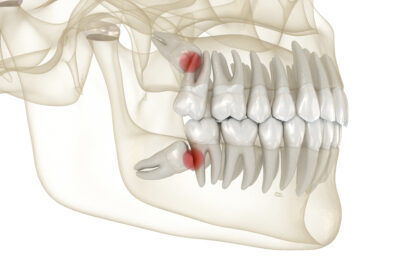By the time gum inflammation progresses into full blown periodontitis (literally “an infection of the area around the tooth), a serious bacterial infection has established itself far below your gum line. Your body – specifically, your immune system – senses the presence of infection and responds as it’s supposed to. It attempts to protect the body at large by destroying the infected part of the body, in this case the gums, connective tissues, and alveolar bone (the pocket of bone that anchors the teeth roots). In pictures taken with advanced dental imaging, like digital x-rays and CT scans, the atrophied bone visibly draws away from the tooth, revealing the darker tooth roots.
Problems Associated with Jaw Bone Loss
Most people with gum disease-related bone loss experience one or more of the following problems:
- Weakened, shrinking bone and connective tissue cause the teeth to become loose in their sockets. Unless they can be re-secured via tissue grafts, the teeth will either fall out or have to be removed.
- Tooth loss and withered jaw bones can give your face a shrunken appearance, making even younger people look older and far less healthy than they may actually be.
Treatment Options for Gum Disease-Related Bone Loss
It can take years for a severe periodontal infection to develop, so most people who are diagnosed with gum disease-related bone loss haven’t been to the dentist in many years. If your dentist discovers gum disease and resulting bone loss at your appointment, he will probably suggest a dynamic treatment plan designed to treat the infection and repair the damaged tissues. This could include treatments like:
- Scaling and Root Planing. More commonly known as a deep cleaning, this procedure involves removing built up tartar and plaque from below the gum line and smoothing down the surfaces of the roots to prevent buildup of further plaque.
- Antimicrobial therapy. This could include topical ointments or prescription mouthwashes.
- Gum grafting. A trained dentist can take a sample of your own gum tissue and graft it to the gums to help regenerate tissues lost to infection.
- Bone grafting. Like a gum graft, bone grafting takes your own cells (or, in some cases, donor or synthetic cells) and uses them to generate healthy new bone cells in the jaw.
About Shawn Hofkes, DDS
With advanced training in oral and maxillofacial surgery, Shawn Hofkes, DDS is qualified to treat all stages of gum disease and perform restorative gum and bone grafts from our state-of-the-art dentist office in Cerritos, CA. To schedule your appointment or consultation with Dr. Hofkes, contact us today. We proudly serve patients of all ages from Cerritos, Lakewood, Long Beach, Buena Park, and all surrounding communities.














